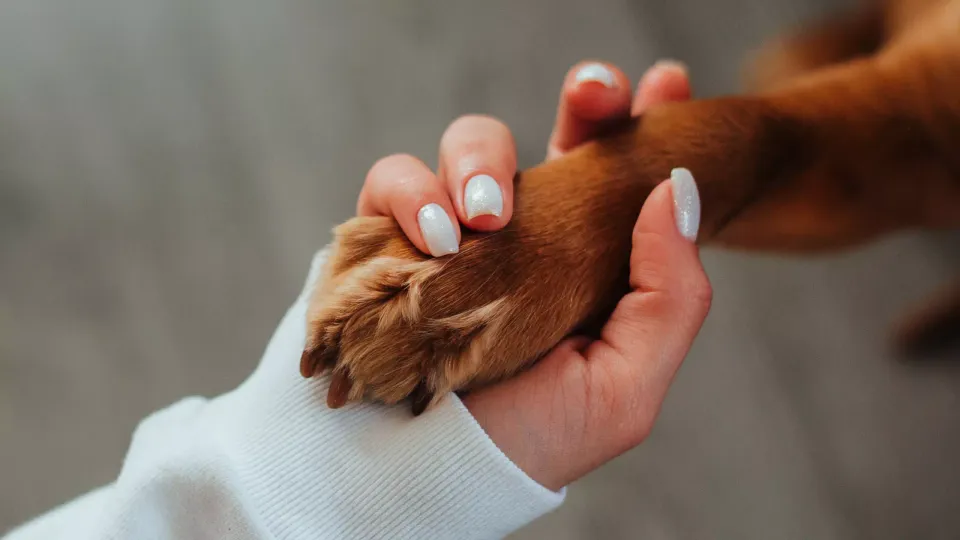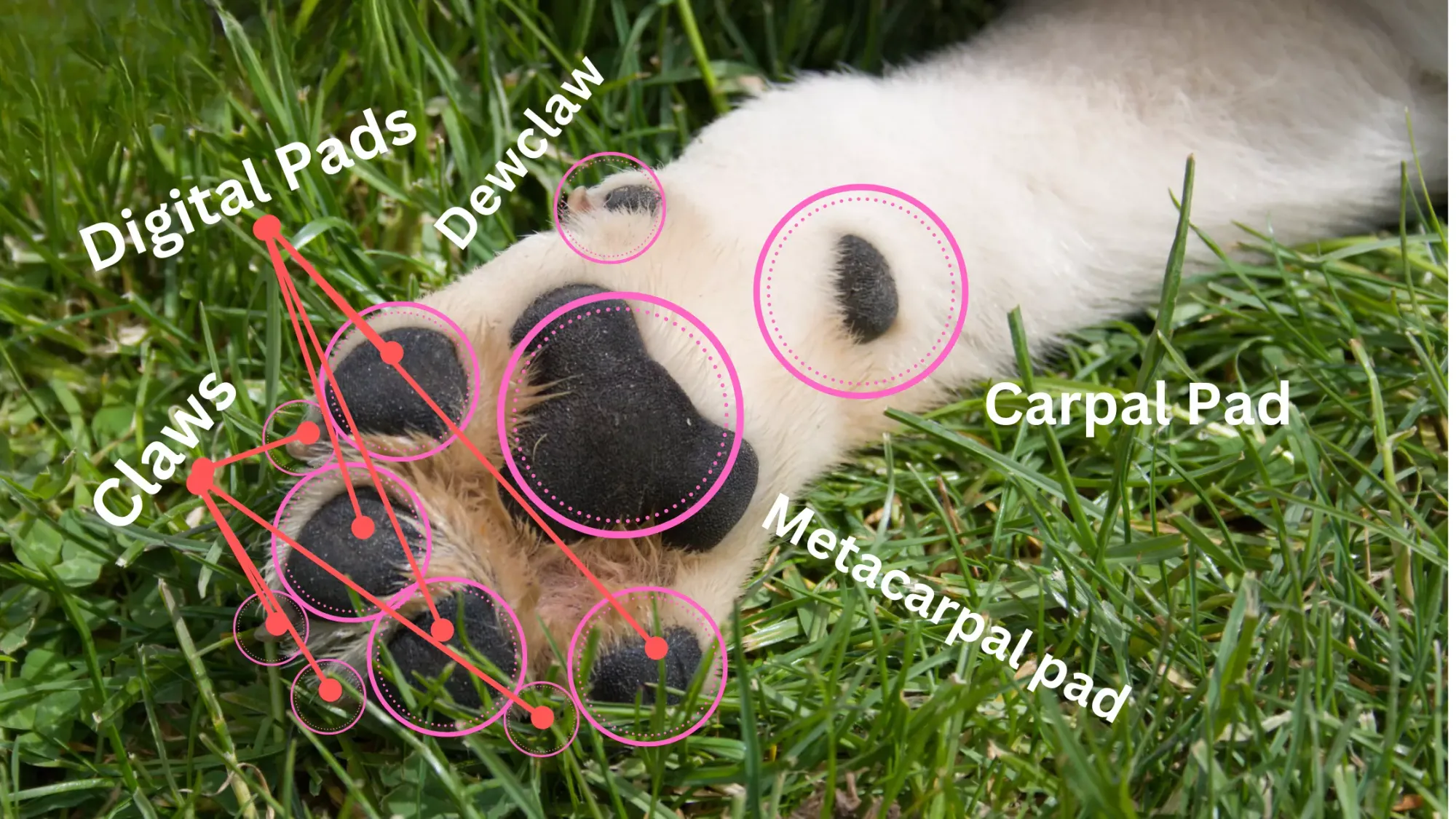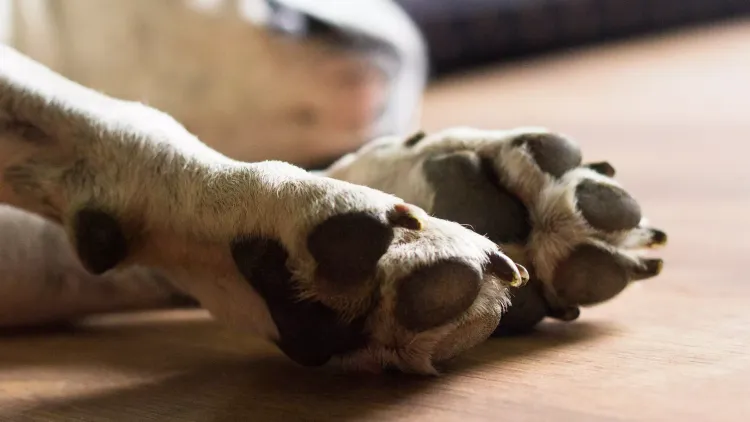Dog Paw Anatomy

Every dog owner is familiar with the soft touch of their pet's paws, but few understand the intricate anatomy and the importance of these remarkable structures. Dog paws are not just cute; they are engineering marvels that provide cushioning, traction, and sensory information. Let's embark on a journey to explore the fascinating world beneath those furry feet.

The Pads
Dog paw pads, akin to the soles of our feet, are multifunctional marvels of canine anatomy. Composed of a thick layer of fatty tissue covered by tough, leathery skin, these pads act as natural shock absorbers, safeguarding the dog's joints and bones from daily wear and tear. Their unique structure offers insulation against extreme temperatures, with the fatty tissue preventing frostbite in cold conditions and shielding against burns on hot surfaces. Additionally, the textured surface provides essential traction, aiding dogs in navigating slippery terrains, while the numerous nerve endings in the pads allow them to sense temperature shifts, ground textures, and even vibrations.
These pads are not just protective barriers; they're also sensory hubs. Packed with nerve endings, they enable dogs to gather vital information about their surroundings, detecting everything from temperature variations to potential threats. Moreover, the paw pads have an innate ability to heal from minor injuries, thanks to their rich blood supply. However, despite their resilience, it's crucial for dog owners to regularly check and care for these pads, ensuring they remain healthy and free from severe damage.
Digital Pads: The Individual Toes
Digital pads are the individual cushion-like structures found beneath each of a dog's toes. Serving as the primary point of contact with the ground, these pads play a pivotal role in providing cushioning and protection. Their composition, a blend of fatty tissue enveloped by tough, keratinized skin, ensures durability while offering a buffer against the rough and varied terrains a dog might traverse. This unique design aids in absorbing the shock from walking, running, or jumping, thereby minimizing strain on the dog's joints and bones.
Beyond protection, digital pads also enhance a dog's grip and stability. The textured surface of these pads grants dogs the ability to navigate slippery or uneven grounds with ease. Moreover, packed with nerve endings, digital pads act as sensory receptors, allowing dogs to feel and interpret the nuances of the surfaces they tread upon. From hot asphalt to icy paths, these pads ensure that our canine companions move confidently and safely in their environment.
Metacarpal Pad: The Palm of the Paw
The metacarpal pad, often referred to as the "central" or "main" pad, is the large, heart-shaped cushion located centrally on a dog's paw, behind the digital pads. This pad plays a crucial role in bearing the majority of a dog's weight, especially when they stand, walk, or run. Composed of a dense layer of fatty tissue shielded by resilient, keratinized skin, the metacarpal pad acts as a shock absorber, protecting the dog's metacarpal bones and joints from the stresses of daily activities and varied terrains.
Beyond its protective function, the metacarpal pad also offers stability and balance. Its broad surface area ensures even weight distribution, allowing dogs to maintain their balance on diverse surfaces, from slippery floors to rugged trails. Additionally, its textured surface provides added traction, preventing slips and aiding in swift movements. As a central component of the canine paw, the metacarpal pad is indispensable for a dog's mobility and overall well-being.
Carpal Pad: The Wrist Protector
The carpal pad, situated further up the leg from the main paw, is a small, often overlooked pad located on the back of a dog's front leg, just above the wrist or "carpus." Unlike other pads that come into frequent contact with the ground, the carpal pad often remains raised. However, when a dog is running downhill or making a sudden stop, this pad provides extra traction and acts as a skid control, preventing the dog from sliding or losing balance. Its composition, similar to other pads, includes a layer of fatty tissue covered by tough, keratinized skin, offering durability and protection.
Beyond its role in traction, the carpal pad also serves as a protective cushion. When dogs sit or lie down, especially on rough or uneven surfaces, the carpal pad acts as a buffer, safeguarding the carpal joint and surrounding areas from abrasions or pressure sores. Its strategic location and unique functions underscore the carpal pad's importance in a dog's anatomy, even if it's not always in the limelight.
Dewclaw: The Canine "Thumb"
The dewclaw, often likened to a human's thumb, is a small, vestigial digit found on the inner side of a dog's leg, above the main paw and somewhat detached from the rest. While not all dogs have them, when present, they typically appear on the front legs, though some breeds also have them on their hind legs. Unlike other nails that touch the ground and wear down naturally, dewclaws don't have that regular contact, making them prone to grow longer and potentially curl into the dog's skin if not trimmed regularly.
Beyond their evolutionary remnants, dewclaws play a role in certain canine activities. For some dogs, especially breeds designed for herding or hunting, dewclaws provide added stability when running at high speeds or making sharp turns. They can also aid in gripping objects, like bones or toys, when chewing or playing. However, because of their somewhat loose attachment, dewclaws can be prone to injuries, leading some breeders and owners to consider surgical removal, especially if they don't serve a functional purpose for the dog.
Hair and Fur
The hair that sprouts between a dog's paw pads, often referred to as "paw fur" or "toe tufts," serves several essential functions. Firstly, it offers an added layer of protection, shielding the sensitive skin between the pads from harsh terrains, cold snow, or hot pavements. This fur acts as a barrier, preventing debris, small stones, or ice from getting lodged between the pads, which could cause discomfort or injury. In colder climates, this hair provides insulation, helping to keep the paws warm and reducing the risk of frostbite.
Nails or Claws: More Than Just for Scratching
A dog's nails, often referred to as claws, are robust, keratinized structures that extend from the end of each toe. While they might be commonly associated with scratching, their role in a dog's life is multifaceted. These nails provide dogs with the necessary grip and traction to navigate various terrains, from soft earth to rugged trails. When a dog digs, whether it's to bury a treasure or create a comfortable resting spot, it's their nails that offer the strength and precision to move the soil. Additionally, nails play a pivotal role in a dog's balance and gait, aiding in their overall mobility and agility.
Sweat Glands: Keeping Cool
Unlike humans, who have sweat glands distributed throughout their skin, dogs primarily possess sweat glands in their paw pads. These specialized glands play a crucial role in thermoregulation. While dogs primarily cool themselves through panting, the sweat glands in their paws provide an additional means of releasing heat. When a dog becomes overheated, these glands produce a light perspiration that dampens their paw pads. As this moisture evaporates, it helps to dissipate some of the body's excess heat, aiding in the cooling process.
Ligaments, Tendons, and Bones
At the core of every dog paw lies a complex network of ligaments, tendons, and bones that work in harmony to provide structure, flexibility, and strength. The bones form the primary skeletal framework, giving the paw its shape and rigidity. These bones are interconnected by ligaments, tough bands of connective tissue that stabilize the joints and ensure that the bones move in coordination with one another. Complementing this are the tendons, which attach muscles to bones. They play a pivotal role in facilitating movement, allowing dogs to flex and extend their paws, grip surfaces, and generate the force needed for activities like running and jumping.
The intricate interplay between ligaments, tendons, and bones is essential for a dog's overall mobility and agility. This internal framework not only supports the weight of the dog but also absorbs shock and provides cushioning during movement. Injuries or issues with any of these components can significantly impact a dog's gait and overall well-being. For instance, a torn ligament or tendon can lead to pain, swelling, and reduced mobility. Thus, it's crucial for pet owners to be observant of their dog's movement patterns and seek veterinary care if any abnormalities or signs of discomfort are noticed. Regular check-ups and preventive care can ensure that this intricate system remains in optimal condition, allowing our canine companions to move freely and comfortably.
Conclusion
The anatomy of a dog's paw is a testament to nature's design prowess. Every part, from the pads to the nails, plays a crucial role in helping our canine companions navigate their world. So, the next time your furry friend offers a paw, take a moment to appreciate the marvel that is the dog's foot.
Remember, regular paw checks and care are essential to ensure your dog's feet remain healthy. Always consult with a veterinarian if you notice any abnormalities or if your dog shows signs of discomfort.

